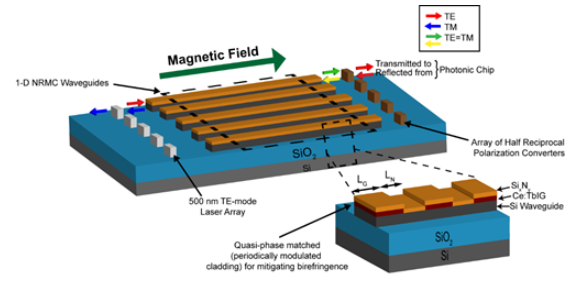High gyrotropy sputtered garnet for photonic isolators
A design and method to fabricate high-gyrotropic optical isolators directly on Si and other common substrates, without using seed layers. This foundry-friendly technology enables creation of smaller, high performance components.

Key Benefits & Differentiators
- Standard semiconductor processing enables easy on-chip integration and smaller components/packaging
- Thin-film garnets can replace bulk isolators and/or enable on-chip laser integration - smaller components and packaging
- High repeatability and reliability enabled by seed layer-free deposition process
- Optimization method based on innate material characteristic ensures high reliability and consistency
- Compatible with both the operation modes, and dimensions, of current integrated lasers
- Isolation ratios comparable to those provided by isolators fabricated using other methods
- Reduced complexity, steps involved, points of failure, cost and time when compared to seed-layer based techniques
Applications
- Photonic Integrated Circuits
- Data storage and long haul communications
- Fabry-Perot rotators
- Integrated quantum and spintronic devices
High performance optical isolators
Optical isolators are unidirectional passive devices used in photonic integrated circuits to protect the laser from destabilizing back reflection of light. The unidirectional nature of an isolator is realized by using the magneto-optical property of rare earth iron garnets. The effectiveness of an isolator largely depends on the Faraday rotation (magnetic gyrotropy), the extent to which the material can rotate (or phase delay) light.
Today, thin layers of magneto-optic materials are grown epitaxially on garnet substrates, using molten saturated baths of lead oxide (a process called liquid phase epitaxy). These are currently used in free space and fiber-coupled isolators (light goes through the thickness of the garnet) For waveguide isolators, academic researchers have found ways to grow magneto-optic materials on semiconductors, but a seed-layer is needed to crystallize the garnet phase. While seed layer-based methods have been shown to produce high quality isolators with high Faraday rotations, the processes involved are not reliable, require several additional steps, and are prone to defects. Additionally, non-reciprocal phase shift (NRPS) based designs are used to obtain large isolation ratios, but this design is so far only practical in TM-mode operation and they are two-dimensional structures. Our waveguide isolator designs are 1-D (higher densities of devices are possible), magnet-free (important to reduce device cross talk and also for applications such as quantum clocks), and work for TE- and TM-modes. Importantly, most integrated lasers are TE-mode.
Researchers at the University of Minnesota have developed a new design and process optimization method to fabricate high performance optical isolators with high gyrotropy. This technology uses a foundry-friendly, seed layer-free, RF reactive co-sputtering process to fabricate an optical isolator directly on Si and other common substrates (like silica). By taking advantage of a temporally-varying characteristic trend(s) arising during the sputtering process, the researchers have manufactured magneto-optical isolators with repeatable Faraday rotation values >-3,200 deg/cm, and optical isolation >30 dB, for 1550 nm infrared light. Moreover, the design and placement of the one-dimensional isolator presented here offers high optical isolation from tapers or device interfaces. Bot
Phase of Development
Proof of concept. Several high Faraday rotation garnet samples have been produced and characterized, both as free space isolators and as waveguide isolators.Desired Partnerships
This technology is now available for:- License
- Sponsored research
- Co-development
Please contact our office to share your business’ needs and learn more.
Researchers
- Bethanie Stadler, PhD, Professor and Associate Head, Electrical and Computer Engineering
-
expand_more library_books References (1)
- Srinivasan, Karthik, Cui Zhang, Prabesh Dulal, Cosmin Radu, Thomas E. Gage, David C. Hutchings, and Bethanie JH Stadler. , High-gyrotropy seedlayer-free Ce: TbIG for monolithic laser-matched SOI optical isolators
-
expand_more cloud_download Supporting documents (1)Product brochureHigh gyrotropy sputtered garnet for photonic isolators.pdf